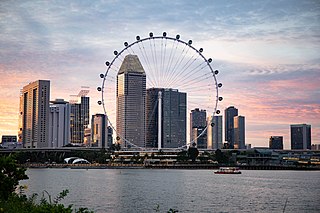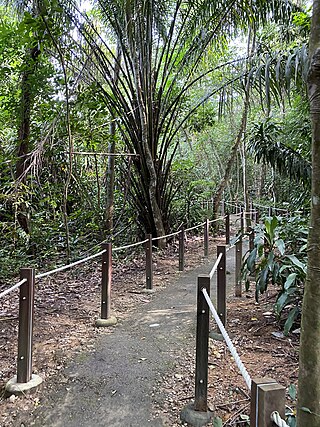
Bukit Panjang is a planning area and residential town located in the West Region of Singapore. A portion of this town is situated on a low-lying elongated hill. The planning area is bounded by Bukit Batok to the west, Choa Chu Kang to the northwest, Sungei Kadut to the north, the Central Water Catchment to the east, and Bukit Timah to the south. Bukit Panjang New Town is located at the northern portion of the planning area. Bukit Panjang has an average elevation of 36m/118 ft.

The Night Safari, Singapore is the world's first nocturnal zoo located in Mandai, Singapore. One of the most popular tourist attractions in the country, it forms a part of the Mandai Wildlife Reserve, consisting of the Singapore Zoo, Bird Paradise and River Wonders and the upcoming Rainforest Wild Park.

The Bukit Timah Nature Reserve is a 1.7-square-kilometre (0.66 sq mi) nature reserve near the geographic centre of Singapore, located on the slopes of Bukit Timah Hill, the country's highest natural peak standing at a height of approximately 165 metres (541 ft), and parts of the surrounding area, located actually in Bukit Panjang. The nature reserve is about 15 kilometres from the Downtown Core, Singapore's central business district (CBD).

The Central Catchment Nature Reserve is the largest nature reserve in Singapore, occupying 2880 hectares. Forming a large green lung in the geographical centre of the city, it houses several recreational sites, including the Singapore Zoo, the Night Safari and the River Safari, as well as several newer facilities built to encourage public appreciation of the reserve, such as the HSBC TreeTop Walk. The reserve sits within the boundaries of the Central Water Catchment. It is one of the four gazetted nature reserves in Singapore. The other three are the Labrador Nature Reserve which was gazetted since 1 January 2002, Sungei Buloh Wetland Reserve and Bukit Timah Nature Reserve. All four nature reserves along with the parks are protected under the Parks & Trees Act 2005.

The Seletar Expressway is a highway in Singapore that traverses the northern end of the island and joins the Central Expressway (CTE) and the Tampines Expressway (TPE) in Seletar to the Bukit Timah Expressway (BKE) in Kranji.

The Bukit Timah Expressway (BKE) is a highway in Singapore that starts at the Pan Island Expressway in Bukit Timah and travels north to the Woodlands Checkpoint and the Johor–Singapore Causeway in Woodlands.

The North Region of Singapore is one of the five regions in the city-state. The region is the second largest region in terms of land area, and has a population of 582,330. Woodlands is the regional centre and also the most populous town with 255,130 residents living in the area. Comprising 13,500 hectares of land area, it includes eight planning areas.

The Expressway Monitoring and Advisory System, also known by its acronym of EMAS, is a computerised system that is used to monitor traffic on Singapore's expressways. EMAS enables Land Transport Authority (LTA) personnel to detect accidents and respond to them more quickly. In addition, it notifies motorists of adverse traffic conditions.

This article shows the notable future developments in Singapore. Most of them are currently under construction with most to be completed within the next five years.
Singapore has about 65 species of mammals, 390 species of birds, 110 species of reptiles, 30 species of amphibians, more than 300 butterfly species, 127 dragonfly species, and over 2,000 recorded species of marine wildlife.

The Raffles' banded langur, also known as the banded leaf monkey or banded surili, is a species of primate in the family Cercopithecidae. It is endemic to Singapore and southern Peninsular Malaysia. The species underwent taxonomic revisions in 2019 and 2020, in which two former subspecies were elevated to separate species. As a result, the Raffles' banded langur meets the criteria for being listed as critically endangered by the IUCN. It is mainly threatened by habitat loss.

Hillview is located in Upper Bukit Timah, Northwest Singapore. The neighbourhood overlooks Bukit Timah Hill, hence its name.

The wildlife of Singapore is surprisingly diverse despite its rapid urbanisation. The majority of fauna that remain on the island exist in nature reserves such as the Bukit Timah Nature Reserve and the Sungei Buloh Wetland Reserve.
CPG Corporation is an infrastructure, building management, and consultancy services company in the Asia Pacific.
Zhenghua Park is a nature park in Singapore bounded by Bukit Timah Expressway (BKE), BKE Slip Road to Kranji Expressway (KJE), and Dairy Farm Road.

Thomson Nature Park is a nature park in Singapore. Opened on 12 October 2019, it is located adjacent to Central Catchment Nature Reserve near Old Upper Thomson Road.
The Mandai Wildlife Bridge is an ecological bridge in Singapore. It links portions of the Central Catchment Nature Reserve that are otherwise separated by the Mandai Lake Road.
Windsor Nature Park is a nature park in Singapore. It was opened on 22 April 2017. The park forms a green buffer zone between Central Catchment Nature Reserve and the urbanized areas of Singapore. The park contains three hiking trails and a canopy walkway.















